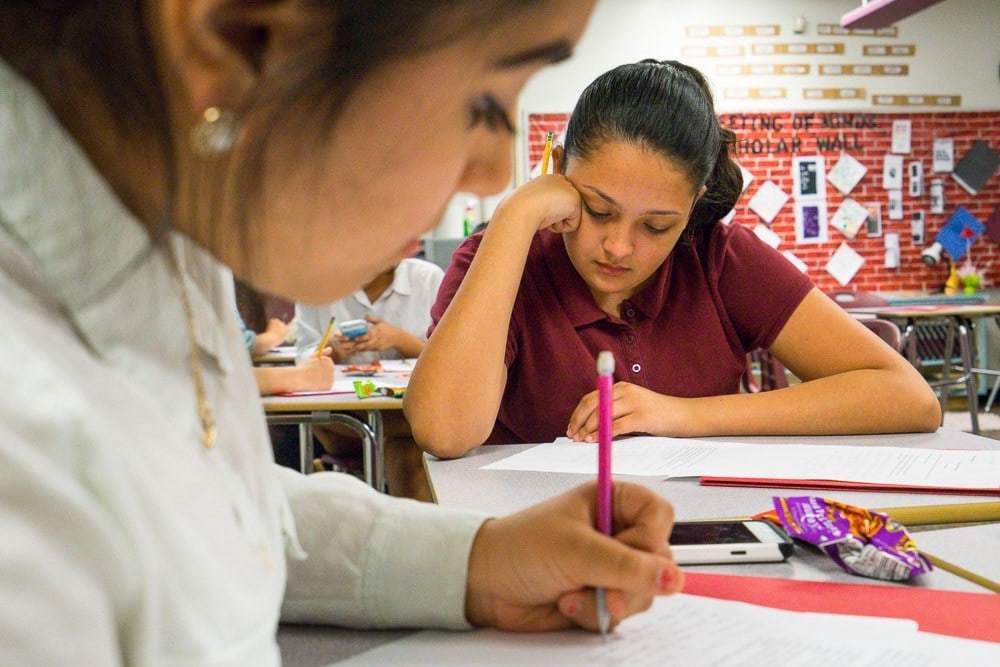
The following excerpt by Mitchell Nobis was originally published in response to Larry Ferlazzo’s question-of-the-week in Education Week Teacher: What is the biggest mistake teachers make in writing instruction and what should they do instead?
Teaching writing is as easy as creating and then herding a batch of cats. A piece of writing must first be born as an idea — no small feat itself — that then must be developed with illustrations and evidence and reasoning, ideally all while having an engaging style and structure. Now get two or three dozen students (or more) per hour to do that with regularity. Then grade it.
How does a teacher triangulate the biggest mistake we make in writing instruction when writing has a million moving parts? To some extent, we start by letting go. Writing is thinking made visible. We may think in visuals, but we define in language. As Ludwig Wittgenstein said, “The limits of my language mean the limits of my world.” We use words to formulate, share, analyze, and discuss ideas, yet we humans hardly teach language at all. We’d be wise to acknowledge that.
Think about toddlers. Most of a child’s words come from just being around adults. Children hear us, and their elastic brains pick up the language. Yes, parents correct toddlers’ “misuse,” often by repeating it back in its accepted form. By then, though, we’re already largely tweaking minutiae. For example, when my three-year-old says, “Daddy, I mad!” I might reply, “Yes, you are mad.” In that scene, no meaning was lost — I merely helped him with syntax. (Of course in reality I’d be ducking the Nerf balls he’d chuck at me in frustration.)
Teaching writing should use modeling too because we write like we read. Too often, schooling separates reading and writing instruction, and then we teach grammar and formulaic structures instead of writing. We need to put reading first while showing students the connections to writing. When we read, we usually focus on content, but our brains work in the background and notice syntactic patterns, vocabulary, where punctuation goes, and more. We can make this process explicit in school. We can invite students to read more, but we can also invite students to discuss the writers’ rhetorical choices. Which character is your favorite, and how did the author make you like her? What is the author’s argument, and how did he make you think and feel about it?
When we shift our focus to modeling and facilitating, we can show options instead of thinking about teachers as arbiters of correctness. There is no correct or incorrect, only appropriate or inappropriate for the context and audience. Once we accept this, we don’t need to teach what’s right. We can just write. To get there, we need to read a lot. We can stop acting like teachers have every answer and instead act as guides in the wilderness of language.
Studies show that we learn grammar and vocabulary best by reading, not by doing exercises. When we read, we absorb patterns and techniques. If we invite students to read as writers, then we can grade as readers, not corrections officers. Plus, when it does come time to study specific rules of grammar, usage, and mechanics, students will better understand how and why rules can help their writing.
When we teach writing as a fill-in-the-blank exercise, our students do not generate thinking, nor do they learn. It is no wonder that we as a nation struggle with deep thinking and analysis — we’ve trained the people to look for someone to tell them what to think and then to repeat it with the commas in the right places (which doesn’t usually happen anyway). We must become better writers, and it boils down to this: Read, write, repeat, and always be thinking.
. . .
Mitchell Nobis is the president of the Michigan Council of Teachers of English, a co-director of Red Cedar Writing Project, and a curriculum support teacher in Metro Detroit with over 20 years of experience in the high-school English classroom. He recently co-authored Real Writing: Modernizing the Old School Essay (Rowman & Littlefield, 2016) and wrote a poem per day for the June 2017 cohort of the Tupelo Press 30/30 Project.

